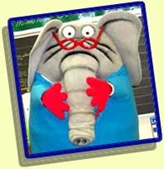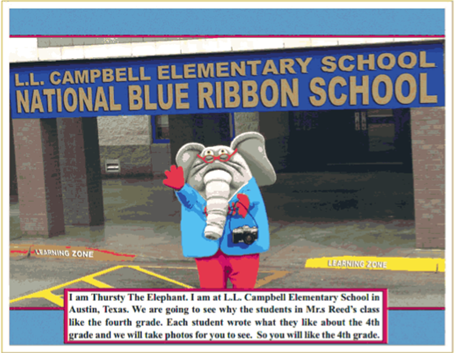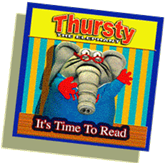Entertainment has always been one of the most effective methods for communicating with children. Working in the music business has shown us how powerful music's influence is on people's lives, especially children.
Children can sing every lyric to popular songs at an early age. They learn them because of the power of rhythm and beat and because they are fun. Thursty the Elephant, a live-action, walk-around cartoon character (http://alturl.com/wa55a) is one example of our paradigm of product-oriented curriculum. That is, educational experiences that result in a product or service that can be sold – a very practical mode of learning, directly connected to the real world which also helps to fund education.
Thursty is proof that our system of character creation and engagement with young people to develop products like books, CDs, music videos, films and other creative outputs is a powerful means to facilitate learning. Thursty also has appeared as an ambassador for education at a number of schools, sporting events, charitable events and other public activities.
This system involves working with children to create a character, bringing the character to life and engaging with the character in a classroom environment to improve their attention span and make learning more fun. We then work with educators to wrap learning elements in packages that children can relate to easily. In the process, they learn teamwork, exercise collaborative creativity and they learn that they can do something that earns money, a valuable element in becoming productive citizens.
Pilot Program
In our pilot program, we enrolled Thursty the Elephant in the fourth grade at Campbell Elementary School in Austin, TX, USA. Right from the start, the character captured the attention of all the pupils in the school. It even garnered the attention of local news outlets that heard that “an elephant is enrolling in the fourth grade!”
The class then undertook a project to write a book called “Thursty Goes To The Fourth Grade.” Each student wrote a few sentences about their favorite activity in school and then supervised a photo shoot with Thursty to illustrate their page. By the time they were out of elementary school, they were published authors with a book in the library. When a book is sold, they get writers’ royalties, the school board receives money and the facilitators also get paid. That is a model that can fund education.

It also taught the children the value of books, the value of reading and they gained the pride of knowing that they created something of value. They wrote a book and proudly boasted about it to their family and friends. The principal of the school noted that the class bonded in a way unlike other classes had because they had something in common. One student in the class improved so much in her reading that she won the city-wide essay contest for her grade level.
Creation of cartoon characters can be used in the same way that mascots become icons for sporting teams. They can become agents for bonding, school or class identity, even symbols for cities, counties or other entities.for children. The class was treated like a “production company” tasked with creative positive music videos for children. This also could be done on the high school level.
Another product created was a CD titled “It’s Time To Read,” using R&B and Hip Hop music to teach ABCs, how to count and character-building qualities like knowing the difference between the truth and a lie, being responsible and other elements important in building integrity and a strong character.
This paradigm of product-oriented learning can be approached holistically to affect students from primary school, middle school, high schools and colleges and universities. At the university level, for example, we created a course on video production that focused on creating positive content for children. The class was treated like a “production company” tasked with creative positive music videos for children. This also could be done on the high school level.
The students made Thursty's first music video, "It's Time to Read.” They wrote, casted, acted, produced, directed and also documented the entire process on video tape. This was an amazing project for students that never work in video or television. The making of this video brought the school to life and gave the students an experience that they will never forget. They worked as a team in a classroom situation with everyone working on one assignment. The “It's Time to Read” video has been aired on local television in Texas for three years and continues to air to this day.
The class teaches students all of the elements of creating a video production from negotiating the contract, forming the concept, creating storyboards, script writing, casting, scouting locations, securing permits for filming, creating or licensing music, camera operation and all of the other elements involved in a collaborative approach to creating a visual product. From the music video projects, they grow in knowledge and skills to elevate to television shows and eventually to the highest collaborative art form – film.

Early Childhood Television Show
A pilot for a television show targeting an early childhood audience was created using the same youths that participated in the creation of the music videos. This is a project that can be done on a collaborative basis where a primary school can partner with a high school. This can be a solution for creating local content while teaching media skills. In all of these projects students learn media skills, which are becoming more and more important as technology and innovation create new tools and opportunities.
Animation Class
We next taught an animation class at St. Edwards University in Austin, TX. The students produced a children’s puppet television show called "The Pet Shop." The students created the concept, wrote the story, made the puppets and did the voiceovers for each character. We created this story for young children to share with them the advantages of working together.
We then worked with another group of students to create another cartoon character named “Wiley the Crab.” The project was commissioned by the College For All Texans Foundation in support of a campaign called “Education. Go Get It.” Student authors from the Hayes Academy, an alternative high school in Kyle, TX, created Wiley. These high school students wrote a bilingual children's book called “Wiley's Way.” The book is about a crab that changes his life by going to college. The purpose of the book was to raise funds for the “Education Go Get It” campaign. The mission of the campaign is to prepare and send an additional 500,000 people to college by the year 2015.
Custom Solutions
The system based on the product-oriented learning paradigm can be customized to address the needs of nearly any school system in any geographical location. By assessing the needs of students, teachers, parents and the community, we identify practical products relevant to the place and culture of the participants.
Innovation and technology have expanded opportunities to create an even greater variety of products such as e-books, learning games, visual content configured for mobile devices and children can even create applications for mobile devices, which is an exploding market worldwide. This approach not only empowers students with critical thinking skills, it builds confidence and social skills through teamwork and generates revenue for cities, school systems and students.


